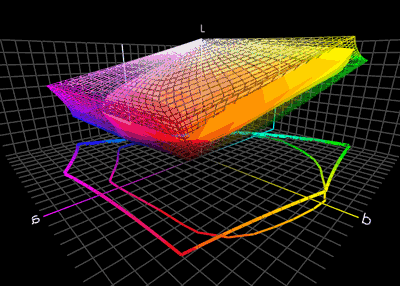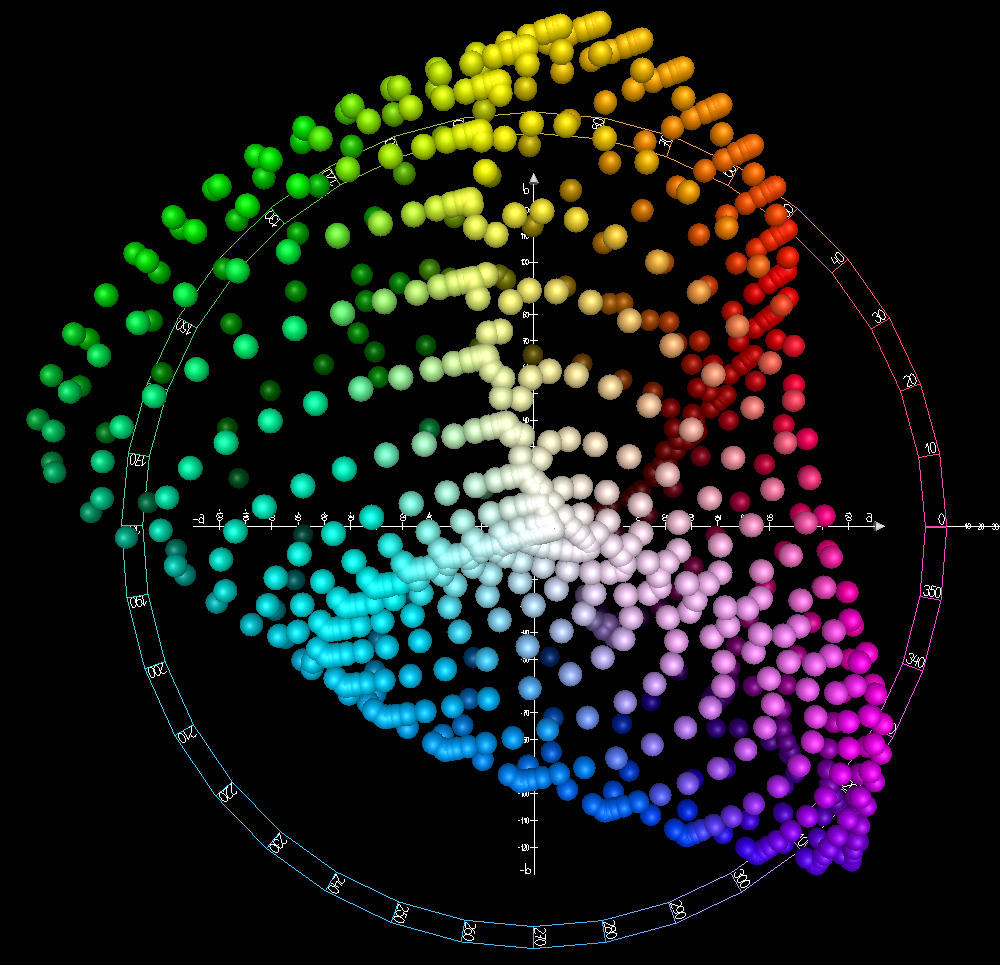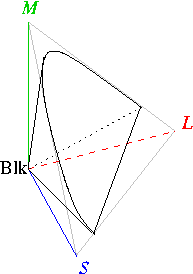|
CIECAM97s
A color appearance model (CAM) is a mathematical model that seeks to describe the perception, perceptual aspects of human color vision, i.e. viewing conditions under which the appearance of a color does not tally with the corresponding physical measurement of the stimulus source. (In contrast, a color model defines a coordinate space to describe colors, such as the RGB color model, RGB and CMYK color model, CMYK color models.) A uniform color space (UCS) is a color model that seeks to make the color-making attributes perceptually uniform, i.e. identical spatial distance between two colors equals identical amount of perceived color difference. A CAM under a fixed viewing condition results in a UCS; a UCS with a modeling of variable viewing conditions results in a CAM. A UCS without such modelling can still be used as a rudimentary CAM. Color appearance Color originates in the mind of the observer; “objectively”, there is only the spectral power distribution of the light that me ... [...More Info...] [...Related Items...] OR: [Wikipedia] [Google] [Baidu] |
Lightness
Lightness is a visual perception of the luminance (L) of an object. It is often judged relative to a similarly lit object. In colorimetry and color appearance models, lightness is a prediction of how an illuminated color will appear to a standard observer. While luminance is a linear measurement of light, lightness is a linear prediction of the human perception of that light. This is because human vision's lightness perception is non-linear relative to light. Doubling the quantity of light does not result in a doubling in perceived lightness, only a modest increase. The symbol for perceptual lightness is usually either J as used in CIECAM02 or L^* as used in CIELAB and CIELUV. L^* ("Lstar") is not to be confused with L as used for luminance. In some color ordering systems such as Munsell, Lightness is referenced as value. Chiaroscuro and Tenebrism both take advantage of dramatic contrasts of value to heighten drama in art. Artists may also employ shading, subtle manipulatio ... [...More Info...] [...Related Items...] OR: [Wikipedia] [Google] [Baidu] |
LMS Color Space
LMS (long, medium, short), is a color space which represents the response of the three types of cones of the human eye, named for their responsivity (sensitivity) peaks at long, medium, and short wavelengths. The numerical range is generally not specified, except that the lower end is generally bounded by zero. It is common to use the LMS color space when performing chromatic adaptation (estimating the appearance of a sample under a different illuminant). It's also useful in the study of color blindness, when one or more cone types are defective. XYZ to LMS Typically, colors to be adapted chromatically will be specified in a color space other than LMS (e.g. sRGB). The chromatic adaptation matrix in the diagonal von Kries transform method, however, operates on tristimulus values in the LMS color space. Since colors in most colorspaces can be transformed to the XYZ color space, only one additional transformation matrix is required for any color space to be adapted chromatically: ... [...More Info...] [...Related Items...] OR: [Wikipedia] [Google] [Baidu] |
Bartleson-Breneman Effect
A color appearance model (CAM) is a mathematical model that seeks to describe the perceptual aspects of human color vision, i.e. viewing conditions under which the appearance of a color does not tally with the corresponding physical measurement of the stimulus source. (In contrast, a color model defines a coordinate space to describe colors, such as the RGB and CMYK color models.) A uniform color space (UCS) is a color model that seeks to make the color-making attributes perceptually uniform, i.e. identical spatial distance between two colors equals identical amount of perceived color difference. A CAM under a fixed viewing condition results in a UCS; a UCS with a modeling of variable viewing conditions results in a CAM. A UCS without such modelling can still be used as a rudimentary CAM. Color appearance Color originates in the mind of the observer; “objectively”, there is only the spectral power distribution of the light that meets the eye. In this sense, ''any'' color perce ... [...More Info...] [...Related Items...] OR: [Wikipedia] [Google] [Baidu] |
ICC Profile
In color management, an ICC profile is a set of data that characterizes a color input or output device, or a color space, according to standards promulgated by the International Color Consortium (ICC). Profiles describe the color attributes of a particular device or viewing requirement by defining a mapping between the device source or target color space and a ''profile connection space'' (PCS). This PCS is either CIELAB (L*a*b*) or CIEXYZ. Mappings may be specified using tables, to which interpolation is applied, or through a series of parameters for transformations. Every device that captures or displays color can be profiled. Some manufacturers provide profiles for their products, and there are several products that allow an end-user to generate their own color profiles, typically through the use of a tristimulus colorimeter or a spectrophotometer (sometimes called a spectrocolorimeter). The ICC defines the format precisely but does not define algorithms or processing deta ... [...More Info...] [...Related Items...] OR: [Wikipedia] [Google] [Baidu] |
Colorfulness
Colorfulness, chroma and saturation are attributes of perceived color relating to chromatic intensity. As defined formally by the International Commission on Illumination (CIE) they respectively describe three different aspects of chromatic intensity, but the terms are often used loosely and interchangeably in contexts where these aspects are not clearly distinguished. The precise meanings of the terms vary by what other functions they are dependent on. * Colorfulness is the "attribute of a visual perception according to which the perceived color of an area appears to be more or less chromatic"., page 87. The colorfulness evoked by an object depends not only on its spectral reflectance but also on the strength of the illumination, and increases with the latter unless the brightness is very high ( Hunt effect). * Chroma is the "colorfulness of an area judged as a proportion of the brightness of a similarly illuminated area that appears white or highly transmitting". As a resu ... [...More Info...] [...Related Items...] OR: [Wikipedia] [Google] [Baidu] |
Brightness
Brightness is an attribute of visual perception in which a source appears to be radiating or reflecting light. In other words, brightness is the perception elicited by the luminance of a visual target. The perception is not linear to luminance, and relies on the context of the viewing environment (for example, see White's illusion). Brightness is a subjective sensation of an object being observed and one of the Color appearance model#Color appearance parameters, color appearance parameters of many color appearance models, typically denoted as Q. Brightness refers to how much light ''appears to shine'' from something. This is a different perception than lightness, which is how light something appears ''compared to'' a similarly lit white object. The adjective '':wikt:bbright'' derives from an Old English ''beorht'' with the same meaning via metathesis giving Middle English ''briht''. The word is from a Common Germanic ', ultimately from a Proto-Indo-European language, PIE root w ... [...More Info...] [...Related Items...] OR: [Wikipedia] [Google] [Baidu] |
Chromatic Adaptation
Chromatic adaptation is the human visual system’s ability to adjust to changes in illumination in order to preserve the appearance of object colors. It is responsible for the stable appearance of object colors despite the wide variation of light which might be reflected from an object and observed by our eyes. A chromatic adaptation transform (CAT) function emulates this important aspect of color perception in color appearance models. An object may be viewed under various conditions. For example, it may be illuminated by sunlight, the light of a fire, or a harsh electric light. In all of these situations, human vision perceives that the object has the same color: a red apple always appears red, whether viewed at night or during the day. On the other hand, a camera with no adjustment for light may register the apple as having varying color. This feature of the visual system is called chromatic adaptation, or color constancy; when the correction occurs in a camera it is referred to ... [...More Info...] [...Related Items...] OR: [Wikipedia] [Google] [Baidu] |
Spectral Power Distribution
In radiometry, photometry, and color science, a spectral power distribution (SPD) measurement describes the power per unit area per unit wavelength of an illumination (radiant exitance). More generally, the term ''spectral power distribution'' can refer to the concentration, as a function of wavelength, of any radiometric or photometric quantity (e.g. radiant energy, radiant flux, radiant intensity, radiance, irradiance, radiant exitance, radiosity, luminance, luminous flux, luminous intensity, illuminance, luminous emittance). Knowledge of the SPD is crucial for optical-sensor system applications. Optical properties such as transmittance, reflectivity, and absorbance as well as the sensor response are typically dependent on the incident wavelength. Physics Mathematically, for the spectral power distribution of a radiant exitance or irradiance one may write: : M(\lambda)=\frac\approx\frac where ''M''(''λ'') is the spectral irradiance (or exitance) of the light ( SI unit ... [...More Info...] [...Related Items...] OR: [Wikipedia] [Google] [Baidu] |
Luminance
Luminance is a photometric measure of the luminous intensity per unit area of light travelling in a given direction. It describes the amount of light that passes through, is emitted from, or is reflected from a particular area, and falls within a given solid angle. Brightness is the term for the ''subjective'' impression of the ''objective'' luminance measurement standard (see for the importance of this contrast). The SI unit for luminance is candela per square metre (cd/m2). A non-SI term for the same unit is the nit. The unit in the Centimetre–gram–second system of units (CGS) (which predated the SI system) is the stilb, which is equal to one candela per square centimetre or 10 kcd/m2. Description Luminance is often used to characterize emission or reflection from flat, diffuse surfaces. Luminance levels indicate how much luminous power could be detected by the human eye looking at a particular surface from a particular angle of view. Luminance is thus an i ... [...More Info...] [...Related Items...] OR: [Wikipedia] [Google] [Baidu] |
Color Management
In digital imaging systems, color management (or colour management) is the controlled conversion between the color representations of various devices, such as image scanners, digital cameras, monitors, TV screens, film printers, computer printers, offset presses, and corresponding media. The primary goal of color management is to obtain a good match across color devices; for example, the colors of one frame of a video should appear the same on a computer LCD monitor, on a plasma TV screen, and as a printed poster. Color management helps to achieve the same appearance on all of these devices, provided the devices are capable of delivering the needed color intensities. With photography, it is often critical that prints or online galleries appear how they were intended. Color management cannot guarantee identical color reproduction, as this is rarely possible, but it can at least give more control over any changes which may occur. Parts of this technology are implemented in the ope ... [...More Info...] [...Related Items...] OR: [Wikipedia] [Google] [Baidu] |
CIELAB Color Space
The CIELAB color space, also referred to as ''L*a*b*'' , is a color space defined by the International Commission on Illumination (abbreviated CIE) in 1976. (Referring to CIELAB as "Lab" without asterisks should be avoided to prevent confusion with Hunter Lab). It expresses color as three values: ''L*'' for perceptual lightness and ''a*'' and ''b*'' for the four unique colors of human vision: red, green, blue and yellow. CIELAB was intended as a perceptually uniform space, where a given numerical change corresponds to a similar perceived change in color. While the LAB space is not truly perceptually uniform, it nevertheless is useful in industry for detecting small differences in color. Like the CIEXYZ space it derives from, CIELAB color space is a device-independent, "standard observer" model. The colors it defines are not relative to any particular device such as a computer monitor or a printer, but instead relate to the CIE standard observer which is an averaging of the ... [...More Info...] [...Related Items...] OR: [Wikipedia] [Google] [Baidu] |
Color Model
A color model is an abstract mathematical model describing the way colors can be represented as tuples of numbers, typically as three or four values or color components. When this model is associated with a precise description of how the components are to be interpreted (viewing conditions, etc.), taking account of visual perception, the resulting set of colors is called "color space." This article describes ways in which human color vision can be modeled, and discusses some of the models in common use. Tristimulus color space One can picture this space as a region in three-dimensional Euclidean space if one identifies the ''x'', ''y'', and ''z'' axes with the stimuli for the long-wavelength (''L''), medium-wavelength (''M''), and short-wavelength (''S'') light receptors. The origin, (''S'',''M'',''L'') = (0,0,0), corresponds to black. White has no definite position in this diagram; rather it is defined according to the color temperature or white balance as desired or ... [...More Info...] [...Related Items...] OR: [Wikipedia] [Google] [Baidu] |








